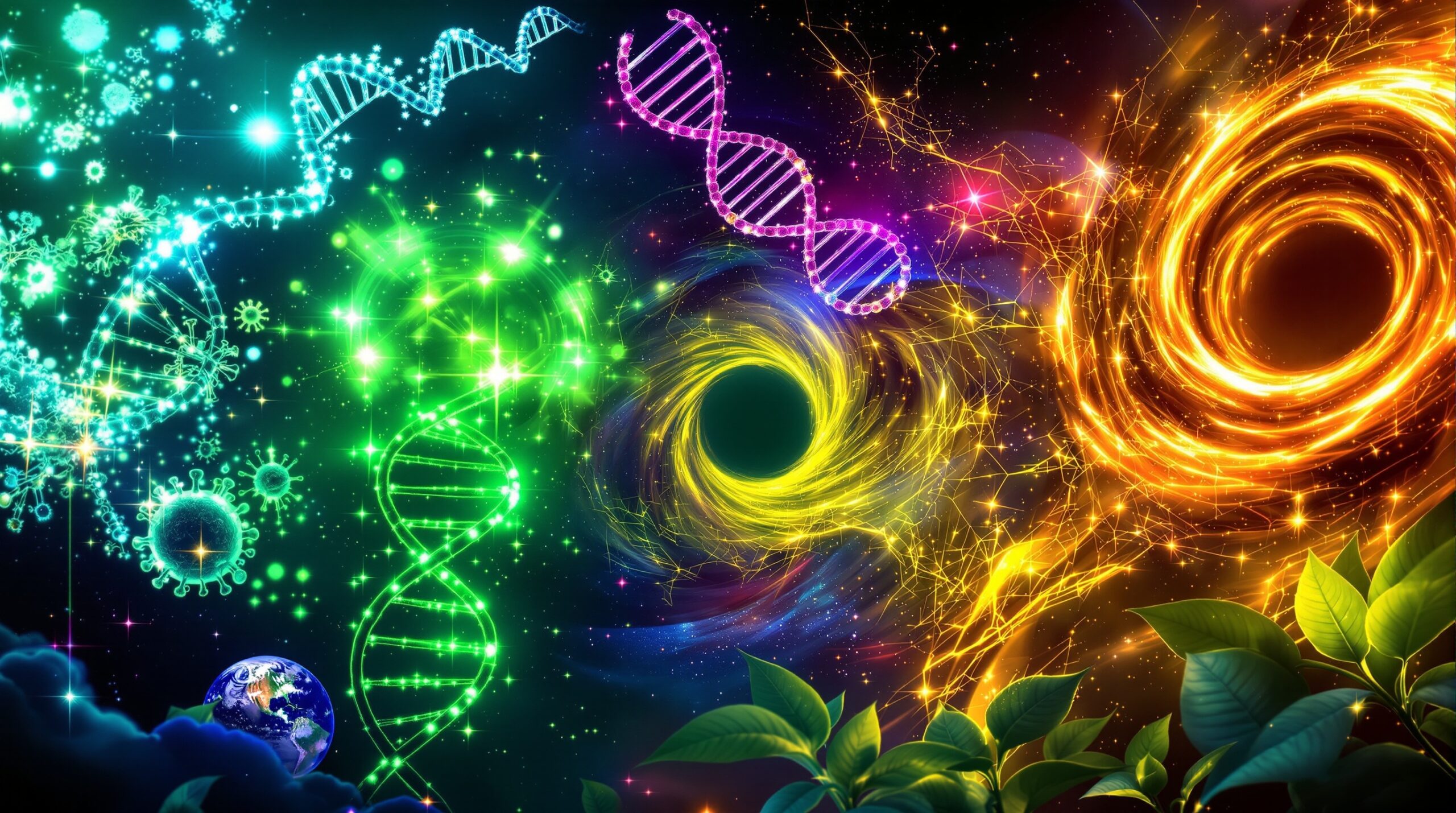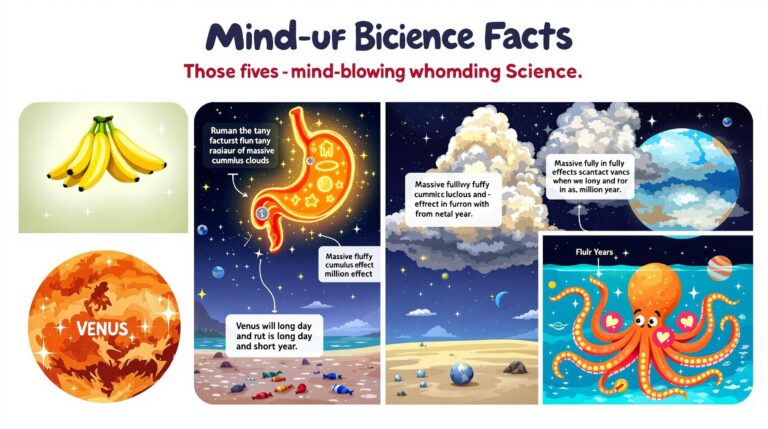Top 5 Mind-Blowing Science Facts That Will Expand Your Horizon
Top 5 Mind-Blowing Science Facts
Introduction
Science constantly pushes the boundaries of what we know, revealing truths that spark curiosity and innovation across the globe.
In this listicle, we explore five extraordinary science facts that highlight the marvels of our world and beyond.
These facts draw from physics, biology, astronomy, and more, offering insights that educate and inspire.
Whether you’re a student in Tokyo, a researcher in New York, or an enthusiast in Sydney, these revelations remind us of the endless possibilities in science.
We base our exploration on reliable sources from leading institutions, ensuring accuracy and depth. Dive in to uncover how these facts reshape our perspective on reality.
Each fact receives a detailed breakdown, including its scientific basis, real-world implications, and why it matters today.
By the end, you’ll gain a fresh appreciation for the intricate workings of the universe. Let’s jump right in!

1. Quantum Entanglement Allows Instant Communication Across Vast Distances
Physicists observe quantum entanglement as particles link in ways that defy classical physics, enabling one particle to influence another instantaneously, regardless of distance.
This phenomenon, first theorized by Albert Einstein as “spooky action at a distance,” challenges our notions of space and time.
Scientists demonstrate entanglement through experiments where pairs of particles, like photons or electrons, share states.
When researchers measure one particle’s spin, the other’s spin aligns oppositely—no matter if they separate by meters or light-years.
In 2022, the Nobel Prize in Physics went to Alain Aspect, John Clauser, and Anton Zeilinger for proving this effect, solidifying its place in quantum mechanics.
This fact impacts technology profoundly. Engineers harness entanglement for quantum computing, where qubits process information exponentially faster than classical bits.
Companies like IBM and Google advance quantum networks, potentially revolutionizing secure communication through unbreakable encryption.
Imagine sending data from Earth to Mars without lag—entanglement paves the way.
Beyond tech, entanglement questions reality itself. Does it imply a hidden connectedness in the universe? Philosophers and scientists debate this, linking it to theories like the multiverse.
For global audiences, this fact underscores how quantum research drives innovations in medicine, AI, and climate modeling. Explore more on quantum entanglement at the official Nobel Prize website: Nobel Prize in Physics 2022.

2. The Human Genome Contains DNA from Ancient Viruses
Biologists reveal that about 8% of the human genome consists of viral DNA remnants from ancient infections, integrated over millions of years of evolution.
These endogenous retroviruses (ERVs) once invaded our ancestors’ cells, but now they play roles in our biology.
Researchers trace ERVs back to retroviruses similar to HIV, which insert their genetic material into host DNA.
Over time, mutations neutralized these viruses, turning them into harmless fossils. A landmark study by the Human Genome Project in 2003 mapped these sequences, showing how they influence gene expression.
This integration benefits us in surprising ways. Certain ERV genes aid placental development in mammals, enabling live births—a key evolutionary advantage.
Scientists at Stanford University link specific ERVs to immune responses, helping fight modern viruses.
However, they also associate with diseases like multiple sclerosis, where reactivated ERVs trigger inflammation.
For a global audience, this fact highlights human evolution’s shared story.
From Africa to Asia, our DNA tells a tale of survival against viral foes.
It fuels advancements in gene therapy, where experts edit ERV-related sequences to treat genetic disorders.
As CRISPR technology evolves, we unlock these ancient codes for better health. Learn about the Human Genome Project’s findings here: National Human Genome Research Institute.

3. Black Holes Emit Radiation and Could Eventually Evaporate
Astronomers confirm that black holes, once thought eternal, slowly lose mass through Hawking radiation, potentially evaporating over immense timescales.
Stephen Hawking proposed this in 1974, blending quantum field theory with general relativity.
Black holes form when massive stars collapse, creating regions where gravity traps even light.
Yet, quantum effects near the event horizon produce particle-antiparticle pairs; one falls in, the other escapes as radiation, reducing the black hole’s mass.
Observations from the Event Horizon Telescope in 2019 imaged the supermassive black hole in M87, supporting these theories.
This radiation implies small black holes evaporate quickly, while stellar ones take trillions of years—longer than the universe’s age. It resolves paradoxes like information loss, suggesting black holes preserve data in subtle ways.
Globally, this fact excites space enthusiasts and drives missions like NASA’s James Webb Space Telescope, probing early black holes. It influences cosmology, explaining galaxy formation and dark matter.
Engineers apply black hole physics to gravitational wave detection, advancing earthquake predictions and navigation. Delve deeper into Hawking radiation via: NASA’s Black Hole Guide.

4. Earth’s Core Spins Faster Than the Surface, Influencing Magnetic Fields
Geologists discover that Earth’s inner core rotates faster than the planet’s surface by about 1 degree per year, generating our protective magnetic field through dynamo action.
Seismic waves from earthquakes reveal this super-rotation, first noted in the 1990s by Columbia University researchers. The solid iron-nickel core, hotter than the sun’s surface, spins due to convective currents in the molten outer core.
This differential rotation creates electric currents, producing the geomagnetic field that shields us from solar radiation. Without it, life faces threats from cosmic rays, disrupting electronics and increasing cancer risks.
Recent studies using data from the International Seismological Centre show the core’s rotation varies, possibly linking to climate patterns like El Niño.
For global citizens, this fact emphasizes Earth’s dynamic interior, aiding disaster preparedness in earthquake-prone areas like Japan or California.
It inspires renewable energy research, mimicking dynamo effects for fusion power. Check out seismic insights at: US Geological Survey Earthquakes.
5. Photosynthesis in Plants Inspires Efficient Solar Technology
Botanists and engineers note that plants convert sunlight to energy with near-perfect efficiency through photosynthesis, outpacing most human-made solar panels and guiding bio-inspired innovations.
Chlorophyll in leaves captures photons, splitting water molecules to produce oxygen and sugars. Quantum biology explains how plants transfer energy with minimal loss, using superposition states.
Harvard researchers mimic this in artificial leaves, creating devices that generate hydrogen fuel from sunlight. A 2024 breakthrough achieved 20% efficiency, surpassing traditional panels’ 15-18%.
This fact addresses global energy needs, combating climate change in regions like Europe and Africa. It promotes sustainable agriculture, enhancing crop yields amid population growth.
Innovators at MIT develop photosynthetic solar cells, reducing reliance on fossil fuels. Explore bio-inspired tech at: MIT Energy Initiative.
Conclusion
These top 5 science facts—from quantum links to photosynthetic marvels—illustrate science’s power to unveil the extraordinary in the everyday.
They not only educate but also drive progress in technology, health, and environmental stewardship.
As we advance into 2025 and beyond, staying informed on such discoveries fosters a connected, innovative world. Share your favorite fact in the comments, and explore more science wonders to keep the curiosity alive.
For further reading, visit authoritative sites like Scientific American or BBC Science for the latest updates. Remember, science evolves—stay curious!





